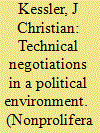|
|
|
Sort Order |
|
|
|
Items / Page
|
|
|
|
|
|
|
| Srl | Item |
| 1 |
ID:
131112


|
|
|
|
|
| Publication |
2014.
|
| Summary/Abstract |
Technology has been long understood to play a central role in limiting the proliferation of nuclear weapons. Evolving nuclear technology, increased access to information, and systematic improvements in design and manufacturing tools, however, should in time ease the proliferation challenge. Eventually, even developing countries could possess a sufficient technical ability. There is evidence that this transition has already occurred. The basic uranium-enrichment gas centrifuge, developed in the 1960s, has technical characteristics that are within reach of nearly all states, without foreign assistance or access to export-controllable materials. The history of centrifuge development in twenty countries supports this perspective, as do previously secret studies carried out by the governments of the United States and the United Kingdom. Complicating matters, centrifuges also have properties that make the detection of a clandestine program enormously difficult. If conditions for the clandestine and indigenous production of weapons have emerged, then nonproliferation institutions focused on technology will be inadequate. Although it would represent a near-foundational shift in nuclear security policy, the changed technology landscape may now necessitate a return to institutions focused instead on motivations.
|
|
|
|
|
|
|
|
|
|
|
|
|
|
|
|
| 2 |
ID:
114434


|
|
|
|
|
| Publication |
2012.
|
| Summary/Abstract |
The negotiating history of Article IV of the Treaty on the Non-Proliferation of Nuclear Weapons (NPT) is analyzed using previously overlooked archival sources. Contrary to received wisdom, there was a lively debate in the spring of 1968, much of it restricted to behind-the-scenes exchanges between Washington and London, over the proliferation risks of gas centrifuge technology for uranium enrichment. The United States put its faith in classification, safeguards, and peaceful use. The United Kingdom feared that clandestine enrichment using centrifuges would render the NPT a dead letter.
|
|
|
|
|
|
|
|
|
|
|
|
|
|
|
|
| 3 |
ID:
127127


|
|
|
|
|
| Publication |
2013.
|
| Summary/Abstract |
Despite a political environment fraught with core policy differences, between 1979 and 1983, six governments and two international safeguards directorates-the International Atomic Energy Agency and the Euratom Safeguards Directorate-negotiated an agreement to preserve the core verification principles behind the Treaty on the Non-Proliferation of Nuclear Weapons (NPT). At first, even agreement to talk was in doubt. Other governments questioned US motives; they wondered whether US motives in promoting the International Nuclear Fuel Cycle Evaluation had been to evaluate or to prevent non-nuclear weapon states from deploying uranium enrichment and spent fuel reprocessing technologies. In addition, Germany and Japan disagreed with the United States on whether NPT safeguards were to address undeclared materials or activities. Notwithstanding this environment, the participants reached agreement first to negotiate, and then on specific technical measures, even when the approach implied a policy consensus where none existed. At the conclusion, agreement was reached on specific technical measures for safeguards at gas centrifuge uranium enrichment plants, and all participating states, including two nuclear weapon states, made diplomatic commitments to adopt this approach for current and future centrifuge plants. This article examines the factors that facilitated agreement and considers what lessons can be learned for future efforts to solve complex technical issues in a politically charged environment and in the absence of complete agreement even on the objectives to be realized.
|
|
|
|
|
|
|
|
|
|
|
|
|
|
|
|
|
|
|
|
|